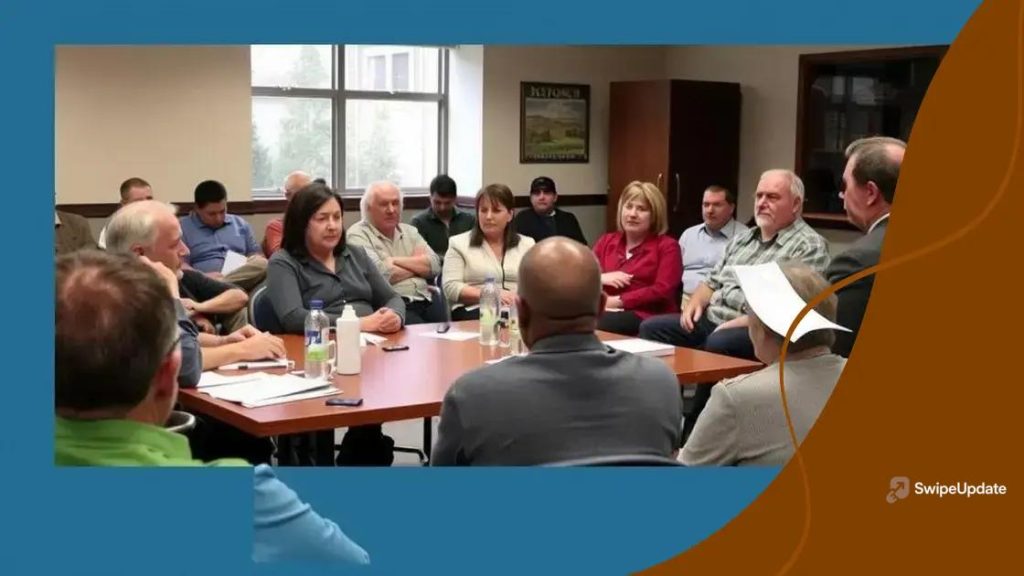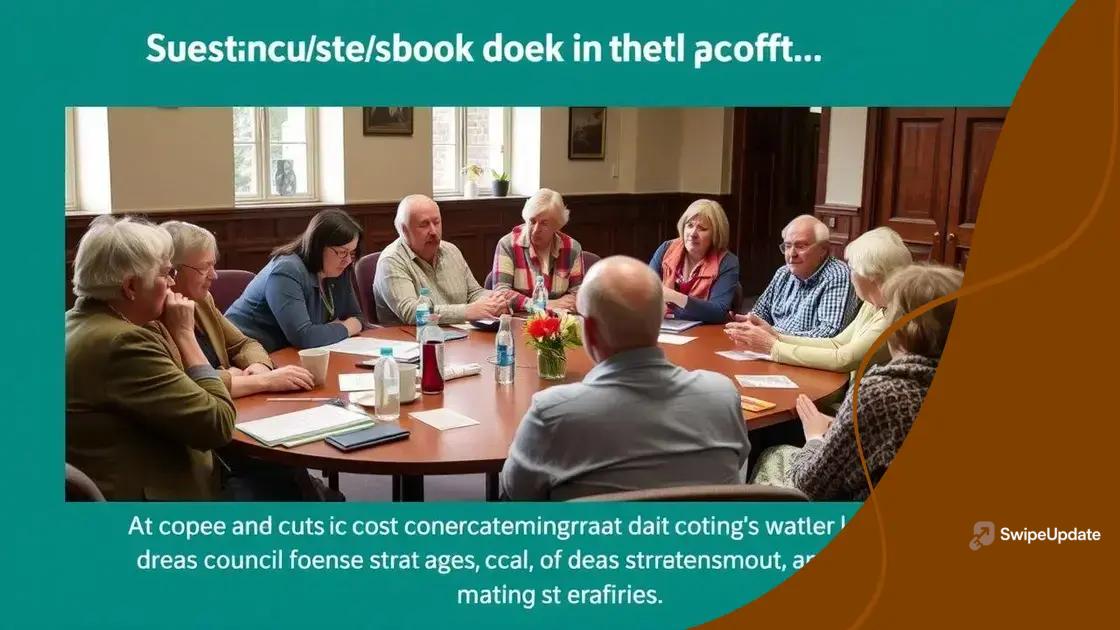Local council cuts: how they impact your community

Local council cuts reduce funding for essential community services, necessitating proactive resident engagement and innovative funding solutions to address the resulting impacts on public resources.
When we talk about local council cuts, it’s easy to feel overwhelmed. What do these cuts really mean for your daily life? Let’s explore the real impacts and what can be done.
Understanding local council cuts
Understanding local council cuts is essential for every citizen. These cuts can significantly affect various public services that we rely on.
When councils decide to cut their budgets, it often leads to reduced funding for essential services. This affects everything from trash collection to community events and even local libraries. Many residents may not fully grasp how these cuts can alter their daily lives.
The causes of local council cuts
Several factors contribute to local council cuts. One primary reason is the reduction in government funding. As central government allocates less money to local authorities, councils must find ways to balance their budgets.
Effects on community services
Such cuts lead directly to various challenges for communities. Key services that may be impacted include:
- Public transportation: Reduced routes and service hours can make it harder for residents to travel.
- Educational programs: Schools may face cuts in after-school activities or funding for essential supplies.
- Public safety: Fewer resources for police and fire departments can affect community safety.
Moreover, elderly services, youth programs, and health initiatives often take the hardest hits, leaving vulnerable populations with fewer resources.
Communities can work together to address these changes. Raising awareness about local council cuts helps residents understand the implications and take action. Residents can attend local meetings and voice their concerns. It’s crucial to have a dialogue with local authorities about what matters most to the community.
By being informed and involved, citizens can contribute to discussions about budget priorities. This awareness can create a more active citizenry committed to ensuring that important public services are preserved amid challenging financial times.
The effect on community services
The effect on community services due to local council cuts can be profound. Many residents may not realize the extent of the impact until they notice changes in their everyday services.
One major area affected is public transportation. Reduced bus schedules can lead to longer wait times and less accessibility for those who rely on these services to get to work or school. This can make commuting more difficult and may even discourage people from using public transport, leading to increased traffic and parking problems.
Impacts on recreational services
Community centers and parks often face budget cuts as well. Local councils may reduce funding for maintenance or activities. As a result, families could find fewer recreational programs available. Many after-school activities, sports leagues, and community festivals may be cut, leading to a lack of opportunities for social engagement.
Reduction in health services
Health clinics and outreach programs may also experience significant changes. Funding reductions can mean fewer staff members and lower availability of essential services. Citizens might find it harder to access medical care or mental health services, which can lead to long-term consequences for community health.
- Transportation: Longer wait times for buses and fewer routes.
- Recreation: Loss of sports leagues and community events.
- Health services: Limited access to clinics and healthcare programs.
Furthermore, budgeting decisions can create inequalities in service provision, with some areas experiencing more severe cuts than others. This discrepancy can lead to frustration and a sense of disenfranchisement within communities.
Addressing these challenges requires active participation from residents. By voicing concerns at community meetings or through social media, individuals can join forces to push for better funding and more attention to the needs of their neighborhoods. Engaging with local decision-makers is essential in ensuring that vital community services continue to thrive.
Coping strategies for residents

Coping with local council cuts requires proactive strategies from residents. Understanding how to adjust can empower communities to navigate these changes effectively.
One of the first steps is to stay informed about local government decisions. This can be done by attending council meetings, reading community bulletins, and engaging with local news sources. Knowledge about budget discussions helps residents to voice their concerns and suggestions.
Building community support
Residents can also build support networks within their neighborhoods. By connecting with neighbors, community members can share resources and information, helping each other find solutions to the challenges posed by service cuts. Community gatherings, such as potlucks or neighborhood watch meetings, can strengthen these bonds.
Advocating for change
Advocacy plays a crucial role in addressing local council cuts. Residents should consider forming or joining advocacy groups. These groups can unite voices to push for better funding and highlight the needs of the community. Engaging in targeted campaigns or petitions can also catch the attention of decision-makers.
- Organize community meetings: Discuss concerns and brainstorm solutions.
- Start a petition: Gather signatures to influence local leaders.
- Utilize social media: Raise awareness of issues affecting the community.
Furthermore, volunteering can provide immediate benefits. Residents can offer their time to local organizations or community groups that may be struggling due to reduced funding. Volunteering not only fills service gaps but also fosters a sense of togetherness and purpose.
Finally, looking into grants and local fundraising opportunities can help support essential services. Community members can collaborate with local businesses and organizations to raise funds to offset some of the service losses caused by council cuts. This collective effort can significantly uplift community resources during tough times.
How to voice concerns to local authorities
Knowing how to voice concerns to local authorities is crucial for residents facing local council cuts. Effective communication can influence decisions and ensure community needs are met.
One of the first steps is understanding the proper channels for communication. Local councils often have dedicated departments for community engagement, providing resources for residents to voice their concerns. Finding the correct contact information through the local council’s website can be helpful.
Writing to local officials
Writing a letter or email is a formal way to express concerns. When drafting your message, it is essential to be clear and concise. Remain respectful while explaining the situation and its impact on the community. Include specific examples to illustrate your points.
Attending council meetings
Council meetings are excellent opportunities to express concerns directly. Residents can attend these meetings to speak publicly during designated times, often referred to as “public comment” sessions. Bringing along data, reports, or testimonials can back your statements effectively.
- Prepare your comment: Write down key points you want to address.
- Practice speaking: Rehearse your comments to stay within the time limit.
- Engage with other attendees: Build support for your concerns by connecting with others.
Moreover, using social media can amplify your voice. Many local councils are active on various platforms where residents can share their thoughts publicly. Engaging with council posts or starting discussions can raise awareness about important issues, bringing more community members into the conversation.
Petitions are another powerful tool. Mobilizing fellow residents to sign a petition can show local authorities that there is a substantial demand for attention to specific concerns. Collecting signatures can lead to more significant resources and a stronger case for the issues at stake.
Finally, collaborating with local advocacy groups can enhance your efforts. These organizations often have established channels for communication and can guide residents on framing their concerns effectively. They may also offer additional resources or strategies to amplify your voice.
Future of local governance and funding
The future of local governance and funding is a critical topic as communities face ongoing council cuts. Understanding the trends and challenges ahead can help residents prepare for potential changes.
As governments at all levels continue to face budget constraints, local councils may have to adapt their funding models. One key approach is seeking alternative revenue sources. This can involve partnerships with local businesses, grants from non-profits, or community fundraising efforts to supplement reduced government funds.
Innovative funding solutions
Many councils are exploring innovative funding solutions. For instance, some may consider implementing local taxes that directly benefit community projects, like parks or schools. Another strategy is to leverage technology for efficiency. By utilizing digital platforms for service delivery, councils can reduce costs while maintaining service quality.
The role of community engagement
Community engagement will play a vital role in shaping future governance. Residents voicing their opinions and participating in decision-making can influence which services are prioritized. As residents advocate for their needs, councils may be more compelled to find creative funding solutions.
- Participatory budgeting: Involves community members in deciding how to allocate parts of the budget.
- Public-private partnerships: Collaborations with businesses to fund community projects.
- Grant applications: Encourages councils to pursue funding for specific initiatives.
Looking forward, trends such as increased transparency and accountability in local governance will likely emerge. Citizens are demanding more information about how funds are allocated and the effectiveness of services provided. As a result, councils that embrace open communication and active feedback will build trust and support within their communities.
Additionally, technological advancements will continue to influence governance structures. E-governance initiatives can streamline processes and enhance citizen engagement. By utilizing online platforms for service requests and feedback, councils can foster a more informed, participatory community.
In conclusion, understanding the impacts of local council cuts is vital for communities. By staying informed and actively participating in local governance, residents can help shape a brighter future. Community support, advocacy, and innovative funding solutions will be essential as local councils navigate budget constraints. Embracing technology and engaging in open dialogues will allow communities to thrive despite challenges.
FAQ – Understanding Local Council Cuts and Community Impact
What are local council cuts?
Local council cuts refer to reductions in funding or services provided by local government, often impacting community resources.
How can residents voice their concerns about funding cuts?
Residents can voice their concerns by attending council meetings, writing letters to local officials, or engaging on social media.
What are some strategies to cope with council cuts?
Forming support networks, advocating for community needs, and volunteering can help residents cope with the effects of cuts.
What is the future of local governance?
The future of local governance may include innovative funding solutions, greater community engagement, and the use of technology for efficiency.
